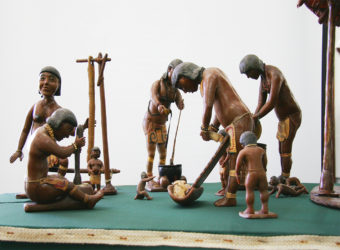Stanley Greaves: It is a pleasure to see George Tancredo’s work again for several reasons. There was a time when artists including myself, made use of imagery from the culture of our Indigenous people. I stopped after three attempts realising that such imagery was the outcome of their perspective on life and I had to find mine. I also hoped that the day would come when artists from the Indigenous community would begin to assert themselves. That did happen. Tancredo’s figurines are like a history of traditional cultural activities, using the word to mean everything associated with a culture. The figurines definitely belong in the realm of fine craft as opposed to fine art, which does not imply in any way a lower status.
Akima McPherson: Fine craft is high status craft – it exists to be valued aesthetically as well as to be functional, although its aesthetic value may be so high as to render it sacred to utility.

George Tancredo
Balata
1999
Tancredo’s A Dream of my Ancestors and the Past, for me, is art. Art generally exists firstly to excite our aesthetic sensibilities, while craft exists firstly to serve utility purpose.
Art also does things craft generally does not – it engages the intellect and it records history and culture amongst other things. Unlike the Greek vases of antiquity (and of other cultures) which did these things and were capable of utilitarian function, Tancredo’s work has no utility function. I call Tancredo’s work art. He has used non-traditional material to sculpt, so the work is contemporary. He has brought to three-dimension, scenes that could have been subjects of paintings. As individual figures the
art value of the figurines are minimal. Placed within the collective they contribute to a valid work of art. I think the question is its display; does it work optimally? To my mind, given a different sort of display the work can be more engaging. Is this the craftsman-turned-artist or the Gallery?
SG: Fine craft stands on a razor’s edge. In a utilitarian sense it can be decorative, in an art sense it contains interests which are based on what can be defined as art… this in itself still is an area of philosophical debate. While it is of interest to decide what to call Tancredo’s work there is the unanswered question of what his intentions were. As art the work could be “Reportage” – a traditional art form presenting an objective view of things seen.
As fine craft it demands close attention together with its decorative function. Whose decision is it? It is for the artist/maker to define his/her position or intention? Back to the work itself. It is contemporary as regards the time in which it is made and not necessarily the materials used. The great attention to authentic fine details and excellent craftsmanship is obvious and appealing. So much so that it actually fits another category that places it in a museum’s anthropological department – the Diorama, a three- dimensional presentation that recreates scenes from social and cultural history providing information for serious study. As regards the reference to Greek vases, l usually try very hard to refrain from trying to draw parallels from cultures far removed from ours unless there is an obvious connection. To conclude, I would consider A Dream of My Ancestors and the Past a very fine Diorama.
AM: Considering that the vast majority of the Western art tradition consists of a series of reactions to Greek antiquity and its values (even from us in these multi-cultural spaces), I do think it is fair game to make the point I attempted. And indeed Tancredo’s work would do well in a museum as a Diorama but that archival work has place in today’s art as well. So while I doubt Tancredo was engaged with that sort of intention, I’m excited by the work’s presence in the Gallery for this proposition.





